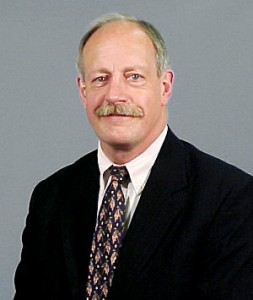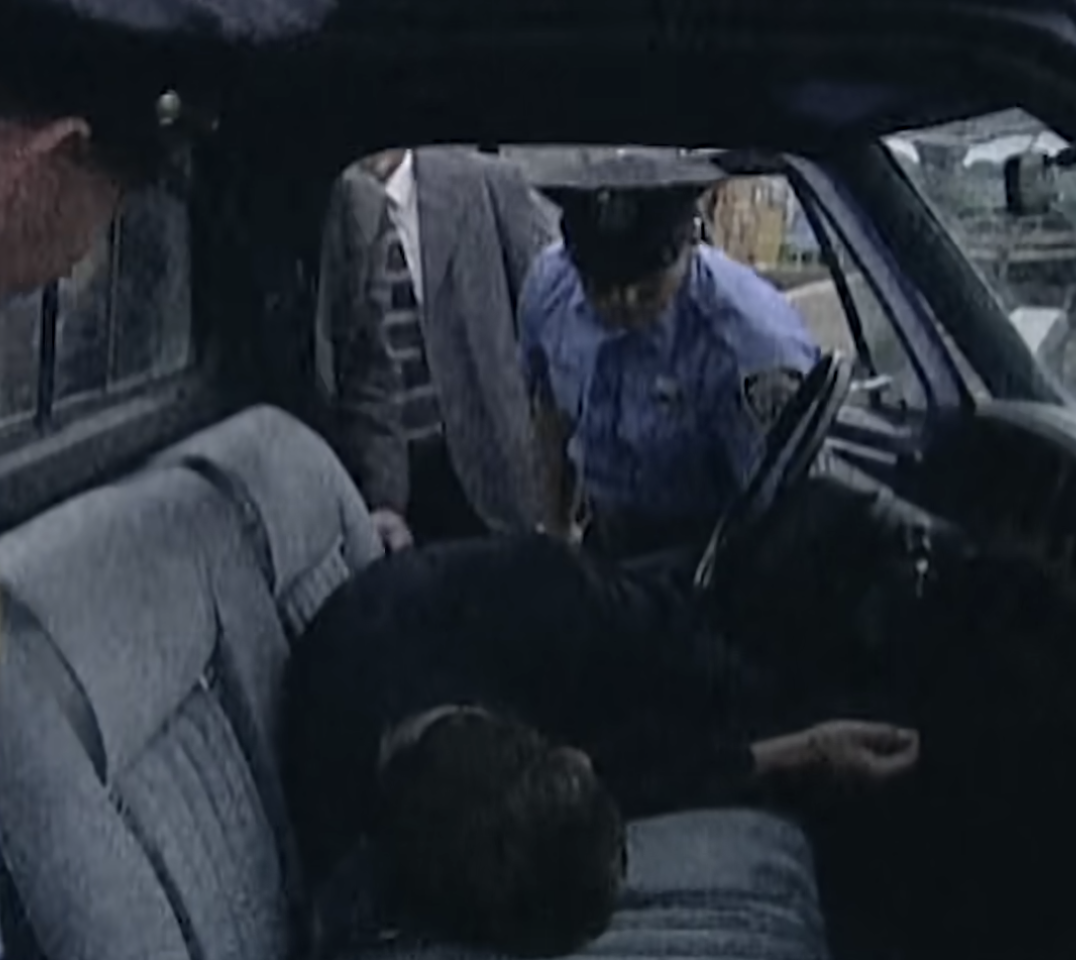
In the summer of 1988, Vincent Loonsfoot, an American Indian, drove to the Hannahville Potawatomi Reservation near Escanaba, Mich. There he ambushed and shot to death four members of his wife’s family and kidnapped his estranged wife. Loonsfoot then set off into the woods – beginning a highly publicized manhunt through the almost impenetrable forest of Michigan’s Upper Peninsula.
Michigan is made up of two peninsulas, the upper and the lower. The Upper Peninsula extends east from Wisconsin and is bounded on the north by Lake Superior. The Lower Peninsula, the bigger of the two, looks like a mitten. So Michiganders tend to point to their hand when giving directions.
The Lower Peninsula is bounded by Lake Michigan to the west and Lake Huron to the east. The shortest distance between the two peninsulas, the Straits of Mackinac, is where the two lakes meet at the top of the Lower Peninsula. For years the only way to get from one peninsula to the other was by boat or plane. In 1957 the Mackinac Bridge was finished allowing for car and truck traffic between the two.
Although the two peninsulas are now connected, they remain dramatically different. In some ways the U.P. remains the pristine wilderness immortalized in Longfellow’s epic poem, “Hiawatha.” “By the shores of Gitche Gumee….” was Longfellow describing the Lake Superior coast of the U.P.
Vincent Loonsfoot and his wife, Peggy, were living near Baraga on the Keweenaw Bay Reservation. An Ojibwa Indian Tribal Court awarded Peggy sole custody of the Loonsfoot’s 2-year-old daughter, based on a finding that Loonsfoot had repeatedly, physically abused Peggy. Peggy was afraid of Loonsfoot, so without telling him, Peggy moved with their daughter to Escanaba on the south/ Lake Michigan side of the U.P.
Loonsfoot followed her, but not being certain where she was staying, he staked out the home of her brother, David Smith, on the Hannahville Reservation near Escanaba. While waiting for Smith and his family to return, Loonsfoot used cocaine and drank beer. It’s not clear if Loonsfoot had a plan, but when the Smith family came home, he ambushed them. Loonsfoot shot and killed David, his wife and two of the daughters, ages 2 and 11. He wounded a third daughter, Amanda, age 10.
Loonsfoot driving the Smith’s car then forced Amanda to take him to the home where Peggy (Amanda’s aunt) was staying. There Loonsfoot kidnapped Peggy leaving Amanda behind. (Amanda would recover from her wounds.) Loonsfoot drove to a ski area outside of Escanaba where the car stalled. Then Loonsfoot set off into the woods with Peggy who was barefoot and 3 months pregnant. He had no provisions, and only the clothes they were wearing. He did have a .30 caliber lever-action rifle and some knives.
Because the murders had occurred on an Indian Reservation, the crimes fell under federal jurisdiction. The Marquette FBI office was notified. (Marquette is the largest city in the U.P. and is on Lake Superior.) When the Marquette FBI agents were able to assess the situation, they called the main Michigan FBI office in Detroit. It was decided that the FBI SWAT team would be dispatched to the U.P. to conduct the search for Loonsfoot and Peggy.
In the meantime State and County law enforcement were attempting to cordon off the area around Escanaba to keep Loonsfoot from escaping the area. The FBI SWAT team was flown to the U.P. in an Air Force National Guard C-130. I was a SWAT team leader, but was in the midst of a trial in which I was case agent and couldn’t deploy until it was concluded.
The SWAT team was on the ground and searching within 48 hours of the murders/abduction. The trail was cold and the woods extremely thick. Tracking dogs were able to pick up a scent. It appeared Loonsfoot was using railroad right-of-ways, but would periodically go into the woods to avoid detection. Trains leaving the area were searched. Aircraft were also used in the search, but they had not made any sightings.
Loonsfoot seemed to have been moving in a westerly direction from Escanaba. Making the search more difficult, it was the height of the blackfly season and the woods were full of voracious ticks. The SWAT guys made a game of picking ticks off each other at the end of the day – seeing who had collected the most.
There were several possible sightings of Loonsfoot and Peggy by local residents and reports of eggs being pilfered from local farms. Response to these sightings hadn’t resulted in any confirmation of Loonsfoot’s past or present locations.
The search had been ongoing for about a week when my trial ended. The following day I headed for the U.P. It was over 400 miles from my home in Ann Arbor to Escanaba, not as the crow flies, but I had to drive my Bureau car and cross the Mackinac Bridge to get there.
When I arrived in Escanaba, I saw some of the SWAT team guys near the County Fair grounds. I stopped, and they filled me in on the status of the search. They had just finished checking the area based on a sighting, but hadn’t found anything. They directed me to the command post.
At the CP I met with Jerry Craig, the over-all SWAT team leader. Jerry gave me a tour of the area, showing me where the murders occurred and where Loonsfoot had left the car and entered the woods over a week before.
I also learned that the full search would be terminated the following day leaving me in charge with 3 SWAT guys who volunteered to stay: Steve Hancock, Bill Randall and Chuck Smith. We would act as a roving patrol to respond to sightings or other indications that our quarry may be at a location. There was some doubt that Loonsfoot and/or Peggy were still in the area or were still alive. One non-SWAT agent at the CP suggested I be alert for congregations of crows or buzzards as it might be evidence of human carrion. A logical tip until you consider how many dead animals there are in the north woods.
The next day I had a sinking feeling as I watched the C-130 rise from Escanaba airport. I was now in charge of a 3 man team searching for an armed and very dangerous Indian and his hostage somewhere in the vast woods of the U.P. I went back to the CP. All the media and their satellite antenna trucks were gone. I reviewed the maps, checking the locations of the sightings, etc. It did seem most of the recent sighting, if they were accurate, were relatively close to town. But it was difficult to connect the dots.
I went to dinner with my team and explained to them what our mission would be starting in the morning. After dinner we all went back to our hotel knowing we would start early the next day. I had no idea how early.
At about 3 am, I was awakened by a call from an FBI supervisor, who had received a call from the Sheriff’s office. Loonsfoot with Peggy had just walked into the Sheriff’s office. Loonsfoot had indicated he wanted to surrender. I called Bill Randall, and we drove to the SO. The other two SWAT agents would follow as quickly as they could.
There was only one person at the SO, the dispatcher. He was in a room separated from the reception area by protective glass. The dispatcher did not want to leave his enclosure for fear Loonsfoot’s intent was less than honorable.
Bill and I approached the SO carefully. We were able to see Loonsfoot and Peggy sitting placidly on a bench in the reception area. We entered guns drawn and ordered Loonsfoot to the floor. He offered no resistance. We handcuffed and searched him. Loonsfoot was shirtless, and we noted with some satisfaction he was dirty and badly bug-bitten.
We also talked to and searched Peggy just to make sure she hadn’t succumbed to the Stockholm syndrome, when a captive becomes sympathetic with their capturer. Peggy looked very tired, but seemed to be in relatively good shape and relieved her ordeal was over. We had the dispatcher call for medical assistance for her.
Later that morning the agents from Marquette arrived to interview Loonsfoot. They would be handling the federal prosecution. I sat in on the interview as Loonsfoot was my responsibility until we turned him over to the US Marshal.
Loonsfoot matter-of-factly confessed to ambushing and killing the Smith family and kidnapping Peggy. It was as though he was discussing yesterday’s baseball game. He showed no emotion and seemed to have no regret.
He talked about his first day and night in the woods. He and Peggy had walked to a highway rest-stop west of Escanaba. There Loonsfoot waited all night for a car to arrive. If one did stop, he intended to kill the driver and any occupants and take the car. He waited all night for a car, but none stopped. Only an 18-wheeler pulled into the rest-stop, and Loonsfoot didn’t know how to drive a big truck. That truck driver will never know how lucky he was.
Loonsfoot never made it further than the rest-stop. He and Peggy had doubled back and spent the rest of their time on the run near town. He would retrieve scraps of food from garbage. One night when it was raining they slept in a dumpster. Loonsfoot was not a skilled woodsman, just an urban Indian.
During the interview, Loonsfoot looked at me and said: “I saw you a couple of days ago by the County Fair grounds. You were standing by a white car (my Bureau car) and talking to some guys with rifles, wearing vests and helmets. You weren’t wearing a vest or helmet. I had you in my sights and I was going to shoot you. But I knew if I did the guys with the rifles would have got me.”
Like that unknown truck driver, the angel of death had apparently passed me over too.
I asked him where his rifle was. He said it was in a field behind the grocery store not too far from the Fair grounds. At first light, Bill Randall and I drove to field and within minutes found the lever-action rifle. It still had a round in the chamber. That bullet had special significance for me.
When we got back to the SO with the rifle the media had returned as had the hierarchy from the FBI office in Detroit. There was also a crowd of local citizens many of them Indians.
It would be my responsibility to arrange for Loonsfoot’s transfer to Marquette where there was a Federal District Court and a US Marshal who would take custody of Loonsfoot for prosecution. Marquette is about 65 miles north of Escanaba. My concern was for Loonsfoot’s safety. I was feeling like Van Heflin’s character* in the movie, “3:10 to Yuma,” having to transport a notorious bad guy, knowing his gang was waiting to spring him. Only those Indians in the crowd outside didn’t want to help Loonsfoot to escape. They wanted revenge; he had killed most of an Indian family from their community. *In a later version of the movie the character was played by Christian Bale.
My plan was to use 3 vehicles. The two agents from Marquette would be in the lead car as they were familiar with the route. I would put Loonsfoot in the second car with the other 3 SWAT agents who would be armed with automatic weapons. I would be in the tail car with my Remington 870, literally riding shotgun.
I planned to load the cars in a big garage attached to the SO and then just drive out, en-route to Marquette. But I was overruled, as the media wanted a “perp walk” outside. We would just have to put a Kevlar vest on Loonsfoot, walk him to the car and hope there were no Jack Rubys (potential assassins) in the crowd. The whole transport operation went smoothly although I kept thinking about contingencies like a big tree lying in the road portending an ambush.
After turning Loonsfoot over to the US Marshal, we returned to Escanaba. The sense of relief in the town was palpable. There was no longer an armed killer possibly lurking in the woods. We went out to dinner and stayed to celebrate. We didn’t buy our own drinks all night. It seemed like every guy in town wanted to shake our hand and every girl wanted to give us a hug. I felt guilty about accepting this adulation having arrived late to the manhunt, but felt it was my duty to take one for the team.
Epilogue:
In December, 1988, Loonsfoot was tried before a US District Court Judge in Marquette. The Judge found him guilty of 4 counts of 1st degree murder, as well as kidnapping. In February, 1989, Loonsfoot was sentenced to life in prison with no chance of parole. The Judge could have imposed the death penalty under federal law even though Michigan has never had a death penalty.
Peggy Deleon (formerly Loonsfoot) is remarried and still lives in the Escanaba area. She gave birth to a son with whom she was pregnant at the time she was abducted. He is now 23 years old.





